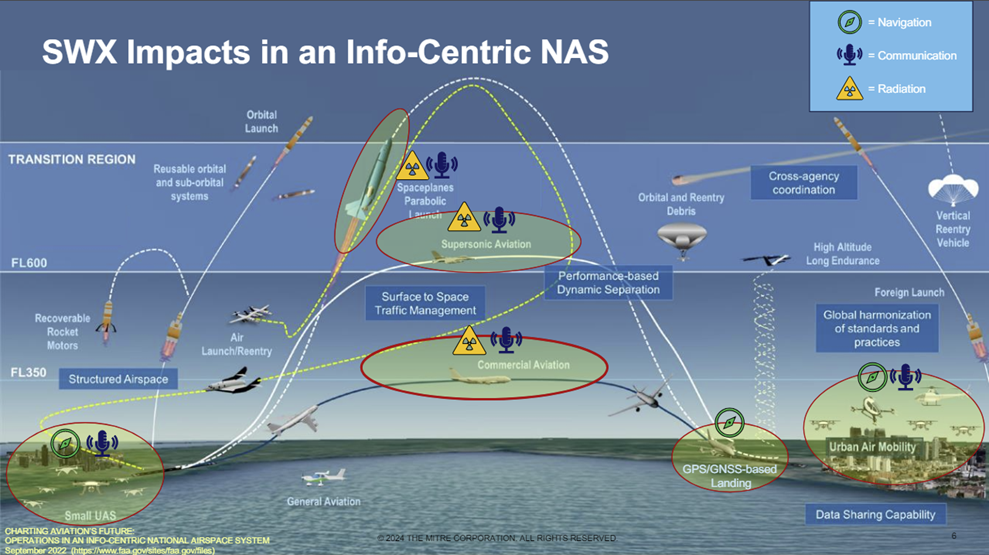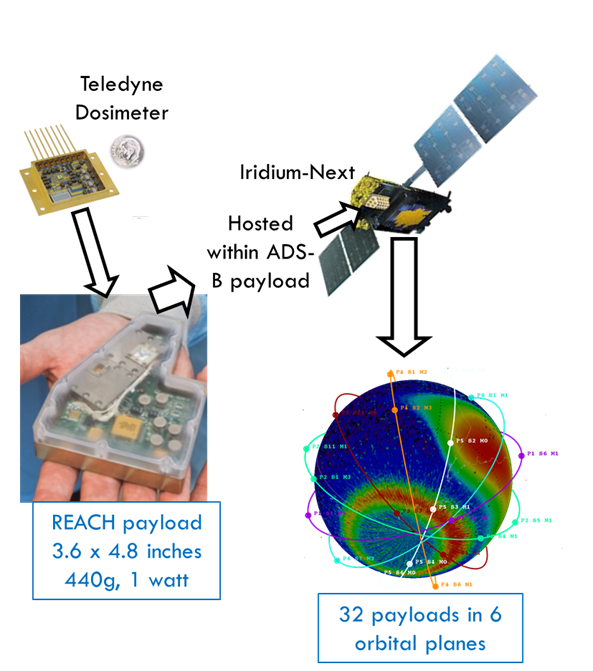Space Weather
Space Weather (SWx) refers to the variable conditions on the Sun and in the space environment that can influence the performance and reliability of space and ground-based technological systems and endanger human health. Adverse SWx, such as solar flares, solar radio bursts, solar energetic particles, galactic cosmic rays, and geomagnetic disturbances, occur relatively regularly, with some having quantifiable effects on essential infrastructure systems and technologies. These can include unanticipated radio communication and/or satellite communication (SATCOM) loss, global navigation satellite system (GNSS)-dependent navigation and surveillance performance degradation, unanticipated on-board electronics performance leading to reboots and anomalies, and problems with radiation exposure for both aircrew and passengers. The Space Weather Aviation (SWxA) program resides within the Aviation Weather Research Program portfolio. Its goal is to improve SWx information used for aviation decision-making to support safer and more efficient aviation operations.
Space Weather Impacts on Navigation, Communication, and Radiation Exposure
Navigation
 GPS/GNSS can be impacted during solar events causing ionospheric disturbances. GPS radio signals travel from the satellite to a ground-based receiver, passing through the ionosphere. Ionized plasma in the ionosphere bends the GPS signal as it travels to the ground. During solar events, the accuracy of these signals can be degraded impairing navigational tools for aviation.
GPS/GNSS can be impacted during solar events causing ionospheric disturbances. GPS radio signals travel from the satellite to a ground-based receiver, passing through the ionosphere. Ionized plasma in the ionosphere bends the GPS signal as it travels to the ground. During solar events, the accuracy of these signals can be degraded impairing navigational tools for aviation.
According to Advisory Circular 91-92, Pilot’s Guide to a Preflight Briefing, pilots must execute proper preflight procedures. This involves becoming familiar with all available information concerning a flight, which includes GPS and GNSS availability or quality issues. Operators must confirm that GPS is expected to be available throughout the operation.
There are more than 2,500 airports, 544 being commercial, in the National Airspace System (NAS) where SWx events could impact aircraft GPS/GNSS-based landings. However, all but 33 have instrument landing systems (ILS). ILS serve as a backup to GPS to support operators at low visibility airports. GPS disruption at airports with no ILS will have only high visibility non-precision or visual approaches limiting access.
During a GPS disruption, the ILS at the 511 commercial airports may not be operationally available due to airport winds, aircraft performance requirements, ILS maintenance, or runway closures. Defaulting to ground-based navigation procedures can result in loss of efficiency leading to possible delays and additional fuel burn.
Communication
 SWx can hinder communication within the aviation community during solar events by causing frequency degradation, and sometimes blackouts. Solar radiation storms, in particular, can render High Frequency (HF) communications inoperable during polar flights. Polar and oceanic regions are most susceptible due to the need for long-range communication.
SWx can hinder communication within the aviation community during solar events by causing frequency degradation, and sometimes blackouts. Solar radiation storms, in particular, can render High Frequency (HF) communications inoperable during polar flights. Polar and oceanic regions are most susceptible due to the need for long-range communication.
HF communications are not the only frequencies impacted – disruptions from solar radio bursts are an issue at any latitude for Very High Frequency (VHF), HF, possible Ultra High Frequency (UHF), and L-Bands. X-rays from solar flares can also result in radio blackouts on the dayside region of earth. The night side region may suffer radio transmissions disruptions from geomagnetic storms.
Several aviation HF radio operators provide global continuous monitoring of impacts to select operational frequencies between 2.1 and 28 MHz. Procedures already exist to help mitigate impacts including shifting to lesser affected higher HF frequencies.
Radiation
 Sources of radiation affecting aviation have galactic and solar origins. These are referred to as Galactic Cosmic Rays (GCRs) and Solar Energetic Particles (SEPs). GCRs typically originate from particle accelerations during explosive events occurring outside of the solar system, for instance, from supernovae. SEPs are charged particles originating from the sun. Both forms of radiation can be harmful to humans and hardware aboard an aircraft.
Sources of radiation affecting aviation have galactic and solar origins. These are referred to as Galactic Cosmic Rays (GCRs) and Solar Energetic Particles (SEPs). GCRs typically originate from particle accelerations during explosive events occurring outside of the solar system, for instance, from supernovae. SEPs are charged particles originating from the sun. Both forms of radiation can be harmful to humans and hardware aboard an aircraft.
Literature has mixed results on effects of ionizing radiation to humans. Most articles are based on models rather than observations and measurements.
Ultimately, the lack of radiation observations at cruise altitudes contributes to this uncertainty. Additionally, health hazards from radiation are difficult to determine because humans have varying lifestyles, which impact their health differently. Radiation is not an acute issue making it more challenging to study its impacts to the general public.
The FAA Advisory Circular 120-61B, In-flight Radiation Exposure, provides basic background information and links to more detailed information. Air carriers are responsible for developing their safety and measurement procedures to inform and protect crewmembers from in-flight ionizing radiation exposure.
The MITRE Corporation, through FAA-sponsored research, highlights space weather hazards in an Info-Centric National Airspace System.

FAA Space Weather Aviation (SWxA) Research Program
The FAA SWxA program kicked off in FY23. The aviation space weather community has made significant strides in effectively communicating space weather threats to aviation. Despite this progress, there is still a need for substantial improvements. The FAA space weather research program is poised to offer valuable insights and enhance our understanding further. Below offers a brief look into recent SWxA research.
FY23
- To promote overall NAS safety through informed risk-based decision-making, the effects of SWx on aviation, focusing on repercussions to aircrews and passengers, must be measured. Literature/datasets on SWx hazards to aviation need to be improved, especially at aircraft altitudes typically frequenting FL320 to FL400. Additionally, there are inefficient and inconsistent procedures for aircraft operations during SWx activity. Because of this, an analysis was conducted in FY23 to identify vulnerabilities and possible contingency capabilities under hazardous SWx events.
- With rapid enhancements and increased reliance on technology, particularly those applying to aviation, radiation forecasts have become a crucial factor in ensuring safety and efficiency. Various operational aviation radiation dose models exist, but their outputs vary, and there are currently limited means of model validation. We determined which current models perform best and support decision-making. This is also timely due to the increase space tourism requiring high-altitude flights.

FY24
- Radiation modeling plays a crucial role in determining the dose rates experienced by flight crew and passengers. However, support for critical observational inputs and further modeling advancements is needed. In 2021, the White House Office of Science and Technology Policy (OSTP) identified SWx support for aviation as a priority and directed federal agencies to implement the SWx observations and modeling necessary to maintain safe operations for aviation during SWx storms. An improved understanding of the geomagnetic field is required to reduce radiation dose uncertainties. Uncertainties in the modeled geomagnetic field, particularly during periods of active SWx, can lead to dose rate uncertainties ranging from a factor of two to more than an order of magnitude for extreme events. Ongoing research is being conducted to leverage the Responsive Environmental Assessment Commercially Hosted (REACH) satellite network data. This involves generating maps of cutoff rigidity approach based on Low Earth Orbit satellites. Ultimately, the aim is to improve aviation-focused SWx modeling by integrating satellite observations into the process.
While space weather forecasting trails behind terrestrial weather forecasting, the gap can be narrowed by expanding satellite monitoring stations and applying methods from weather and climate research. Unlike atmospheric models, space weather models rely on limited observational data, which restricts their ability to provide long-term predictions. The complexity of space weather events, combined with the need for more sophisticated observational and modeling techniques, is a key factor in the difference in forecasting capabilities.
